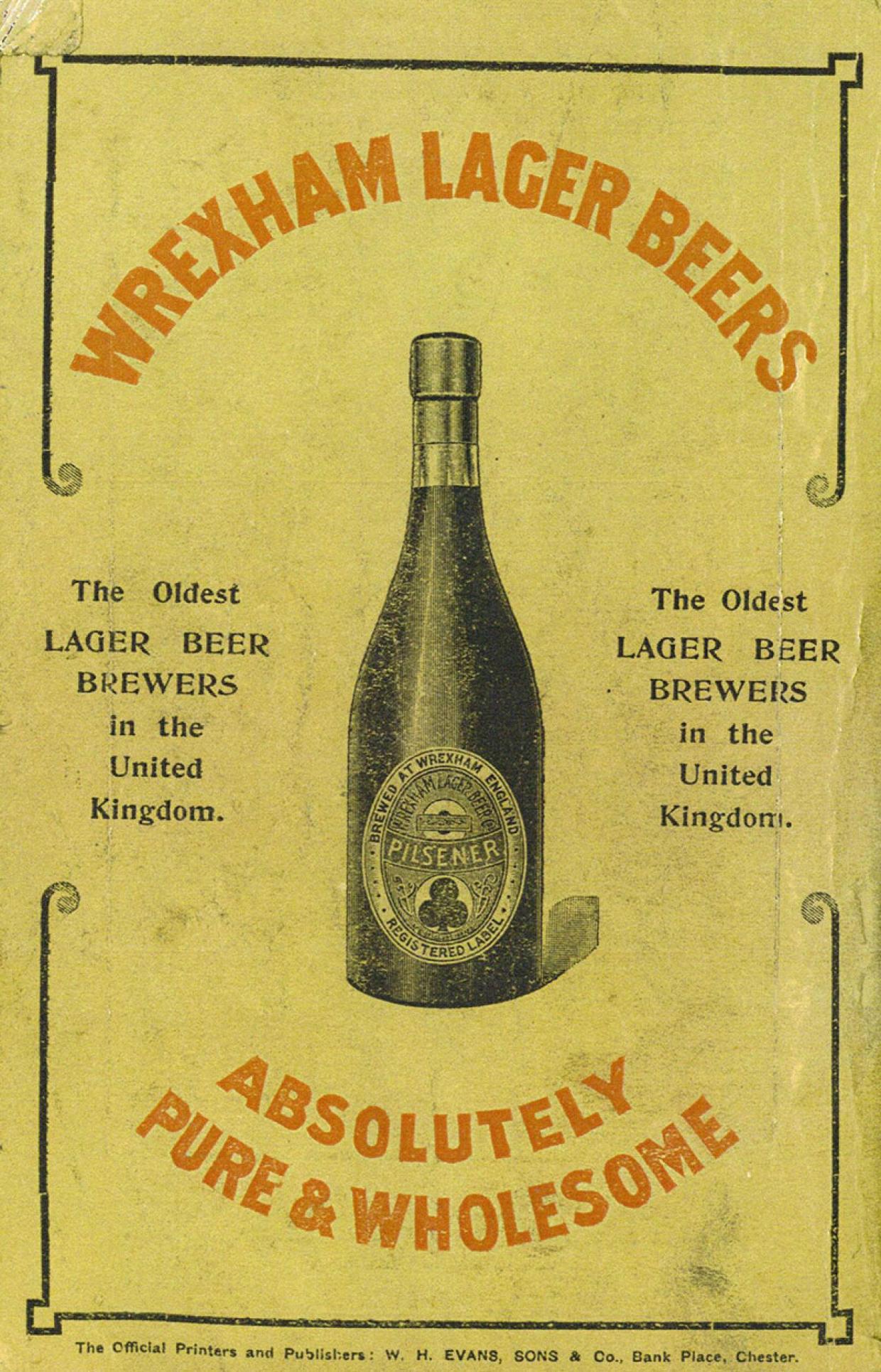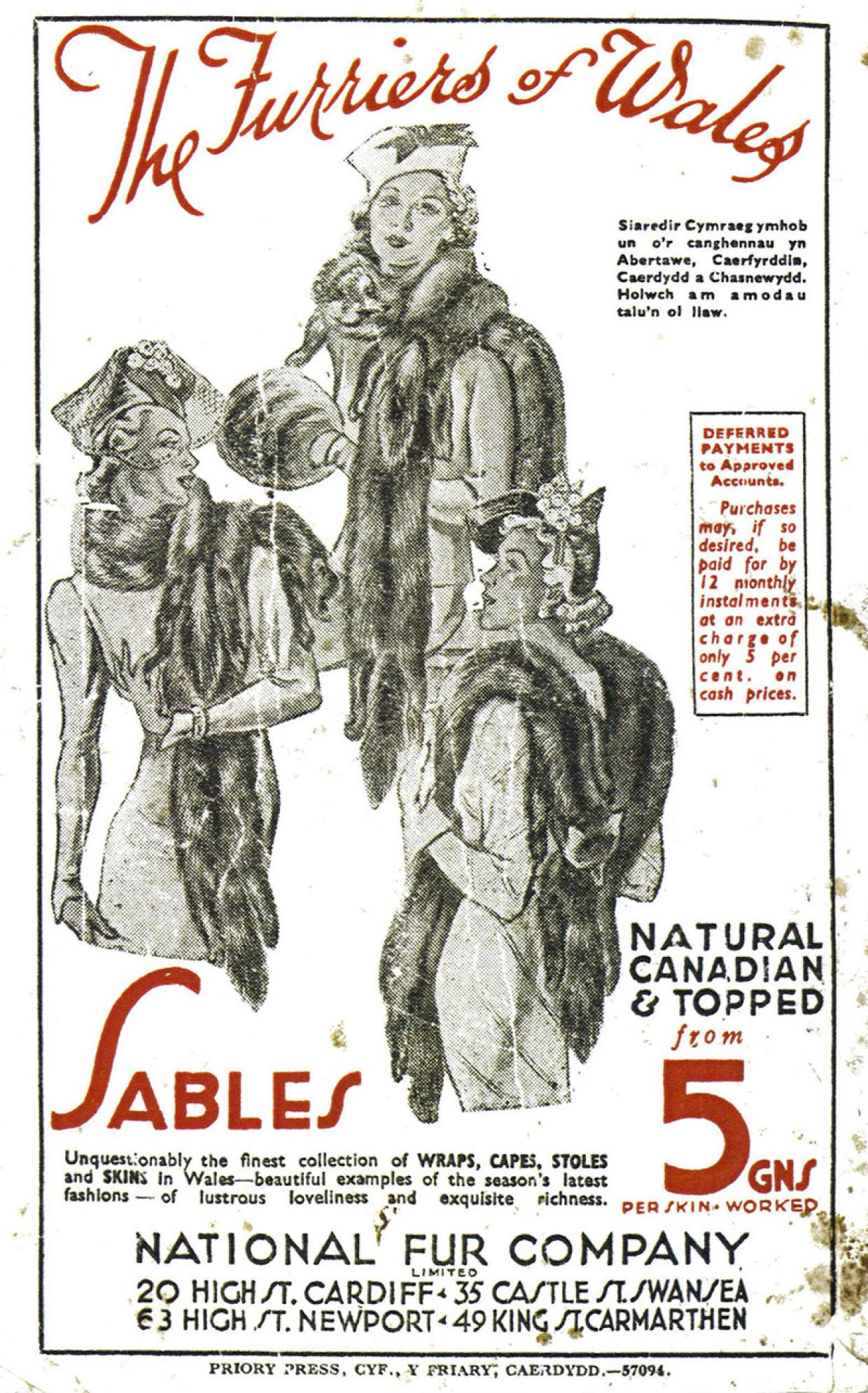Wrexham was home to the Eisteddfod in 1912, and with a substantial programmeme costing sixpence to buy, advertisers of all kinds were eager for their goods and services to feature in this popular volume. This was how everyone planned their visit to the Eisteddfod before the day of the web, television or radio, and businesses and companies saw the programmeme as a great way to reach an important audience.
Few companies or businesses chose to use the Welsh language, although advertising in the programme was a way of reaching a Welsh-speaking audience. Many of the adverts in the early twentieth century sold all sorts of wares - from plates and china to bricks and coal - all available from local businesses local to the Eisteddfod.
One of the most prominent advertisements of the time is the back page of the 1912 programme, an advert for Wrexham Lager Beers - a local company supporting the national festival in their area. However, at the time, and for almost another century, there was no bar on the Maes, and no way to buy a pint of lager or any other alcoholic beverage. But, Eisteddfod organisers were more than happy to take advertising money from alcohol makers in this time of temperence, less than ten years after the Great Reformation, in 1904.
One of the great events of the world in 1912 was the Titanic disaster, which killed hundreds of passengers on their way to America. It feels strange to see an advertisement for the ship's owners, White Star Line and the sister ship of the Titanic, HMS Olympic in the Eisteddfod programme, and it raises the question of whether the advertisement was placed before the Titanic voyage? The company draws attention to the “wireless telegraphy, orchestra and unsurpassed comforts”, but there is no mention of the Titanic itself in the advert.
Hugh Evans and Gwasg y Brython were responsible for printing the Eisteddfod programme for years. Gwasg y Brython was one of Liverpool's Welsh businesses, and the company was also responsible for one of the most prominent newspapers of the period, Y Brython.
The company would spend a considerable amount of time collecting adverts for the Eisteddfod programme each year. The 1921 Eisteddfod Eisteddfod List of Competitions included a full page advertisement, calling on companies and businesses to place advertisements, stating that the programme was “An exceptionally effective medium to advertise in, and one in which you make your appeal to a thoughtful class of people, and one from which satisfactory results are assured.”
They obviously had the contacts and the ability to secure advertising from some of the big companies of the time. Ads from prominent businesses such as Fry's Chocolate and Jacob's Cream Crackers appeared regularly, along with adverts from institutions such as the University College of North Wales, Bangor, which offered courses for a fee of £13 1s a year, with additional laboratory costs .
The names of some of the college's lecturers at the time are well known to us, especially to university alumni, with John Morris Jones, HR Reichel and JE Lloyd all teaching at the college at the time, academics whose names live on in various buildings in the city today.
In 1914, the world changed. Wales, like much of the world, was severely affected by the Great War. The National Eisteddfod in Bangor had to be postponed for a year, and the Black Chair Eisteddfod of 1917 in Birkenhead is one of Wales's most famous events, with Ellis Humphrey Evans, Hedd Wyn, killed on the battlefield a few weeks before the Eisteddfod, having won the Chair. The war was part of everyone's lives, and touched every element of society.
However, this was not reflected in the adverts for the Eisteddfod's list of competitions and programme for some time. The usual advertisements, especially local ones, continued to appear throughout the war. Indeed, there was nothing out of the ordinary in the advertisements in the 1920 Barry Eisteddfod list of competitions (published a year earlier), with many advertisements for clothes shops, magazines, music and pianos filling the pages.
But a major change came when the 1920 programme was published, with a number of adverts promoting products that might not have been seen a few years earlier. 'A boon to the lame' says one, advertising artificial legs and arms. Cardiff-based company JJ Stubbs & Son states, “The motions and actions are as natural as possible, no springs, bolts etc., to get out of order. The yielding and elastic qualities of rubber supply requisite motion; avoid all jars to the stump when walking; absolutely noiseless. ”
Cardiff-based firm Allen Pearce, Artificial Limbs and Surgical Appliance Makers, offered “Artificial legs; light weight and durable; crutches with non-slipping ends; trusses with or without steel bands ”, and“ Artificial eyes: Patent mobile, snellen and shell patterns ”.
Gravestone and monument makers had advertised in the programme occasionally over the years, but one line on John Fletcher Ltd., Monumental Works, Carnarvon’s advert in the 1921 list of competitions draws attention - 'Contractors to HM Government', showing that the company is one of the suppliers producing tombstones for soldiers in Wales and beyond. A world away from adverts for clothes and hats, cafes and hotels that were usually featured in the festival programme.
This was the era of tobacco advertising, something that would not be seen in any programme or list of competitions nowadays. Thomas Nicholls & Co. from Chester regularly advertised during this period, selling Nicholls Union Jack Shag, stating 'Critical Smokers say: “Should be in everyone's mouth'”. And E Morgan and Company, Amlwch were selling their products using the slogan "The best tobacco is Amlwch tobacco: There's no better to smoke and chew".
Adverts for coats and fur hats were often featured in the programme, especially when the festival was being held in an urban area. R Neill & Son Ltd. Liverpool, were regular advertisers, and nowadays, their advertisement in the 1929 Liverpool Eisteddfod programme seems terribly tasteless. It is a cartoon of a rabbit standing outside a shop looking through the window and weeping at the sight of the expensive fur hats, saying "Alas, my poor brother".
Many of these companies have now disappeared, and it is interesting to look at some of the addresses of the businesses when the programmes were published, comparing their use with today. But some advertisements are still relevant and, indeed, almost a century later. The Daily Post regularly advertised in the programme during the 1920s, proclaiming, 'Eisteddfod - you will find detailed reports every day in the Liverpool Daily Post'. Some things certainly never change!



